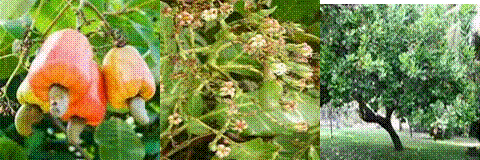ECOLOGICAL REQUIREMENTS
o Altitude: 0-1000m a.s.l.
o Rainfall: Well distributed of over 120mm per annum optimum 2500mm.
o Temperature: 27c- 28c
o Soil: Deep well drained and aerated light sandy soils with pH of 5.0-8.0
PROPAGATION
Nursery:
Should be near permanent source of water.
Select medium sized nuts since they absorb water faster.
Plants in trenches (horizontally) leave a small portion unburned.
Frequent irrigation should be done.
Seedling is ready for transplanting when they produce 6leaves (2 month old).
Main field:
Old stumps and leaves should be burned to control rhinoceros beetle.
Mix FYM, TSP, CAN, MCPA, Magnesium Sulphate in 6-12m (hole)
Spacing: 9×9 tall varieties, 7×7 m short varieties.
Depth: deep, there can be 120-140 plants/ hectare
Preparation and planting
Propagation by seeds “seed nuts” planted in nursery trenches where seedling is maintenance for 9-12 months when they have 3-4 leaves.
Transplanted at beginning of rains. Holes 60cm are dug someday in advance. Nuts of seedling are planted 30-45cm below surface.
Field maintance
NPK 500g/ tree/ year.
Nitrogen should be applied to increase number of flowers.
Weeding done around the stem using hand hoes.
Herbicides application e.g. Paraquat, atrazine.
Pest and Disease control
Pests
1. Rhinoceros beetle: Orycytes monocerous
Damage:
Stuck the terminal bud.
Destroy the unopened leaves and the growing point.
When attacked leaves open they produce v-shaped notches.
Leaves dry up.
Control:
Destroy all decaying trucks, stems, leaves by burning.
Using wire to pierce the beetle.
2. Coreid bug: Pseudotheraptus wayii
Damage: -Suck the juice on young nuts and cause cracklings on the nuts and drop off.
Control: -Biological control by Ocephylla Longinoda i.e. Majimoto ants
3. Termites and other sucking insects.
Control: – Dust with Aldrin around trees.
Diseases
i. Bole rot
Cause: -Fungus Marasuniellus- Cocophilus
Symptoms: -Yellowing of leaves and wilting of plants
Control: – Avoid damaging the roots.
-Avoid infected seedlings.
ii. Lethal yellow disease (viral)
Symptoms: -Light brown irregular lesion starting at the tip of young leaves.
Control: -No chemical control.
-Uproot affected plants.
Harvesting and produce yield:
-First bearing 5-10 years after transplanting.
-Full bearing 10-18 years
-Nuts harvested 7-10months after flowering.
-For copra production, harvesting at full maturity.
Yield: -15-30 nuts per tree
Products from nuts
Margarine, oils, soaps, mattress struffing, baskets, etc.
Dried leaves are used to thatch mats and baskets.
 CASHEW NUTS
CASHEW NUTS
Scientific name: Anacardium Occidentale
Origin: America
Distribution: Ruvuma, Lindi and Tanga in Tanzania
Uses
Cashew nuts apple is used in alcohol brewing.
The apple can be eaten as it provides vitamins to the body.
The stems and branches once dry are used as firewood.
Nuts can be used as food.
Roots used as medicine
Provides the country with forex when sold to outside countries especially cold countries because of oils content used to keep the body warm.
Provides us with oil.
ECOLOGICAL REQUIREMENTS
Altitude: 0-750m a.s.l.
Temperature: favors temperature up to 35c
Rainfall: 750-900mm per 1annum
Soil: Well drained soil with acidic pH 4.5-6.5 i.e. acidic soil
PROPAGATION
The crop is directly propagated using the seeds e.g. the nuts. Also the crop can be propagated by air layering and grafting methods but the use of seeds is more preferable, it should be noted that heavy seeds are most viable. Seed beds are first prepared and these require careful clearing and burning well before sowing.
Sowing is done at the beginning of rains Holes are dug 30cm wide and 5.0-7.5cm deep, seeds are planted 2.5cm apart in each hole. Spacing is 12mx12m or 15mx15m
Field management
Temporary shades are provided over young seedlings.
Thinning is done to one plant per hole after one year.
Pruning might be necessary in the first three year.
Weeding around trees helps during harvesting.
Fertilizer/ manure application is not important or essential for the crop since the crop undergo intense (massive) foliage i.e. dropping of many leaves on to the ground, this act leads to the formation of humus as the leaves decomposes on the ground thus, there will be addition of nutrients in the soil hence no need of adding nutrients by the use of manure nor fertilizer.
But if deficiency of an element e.g. boron deficiency fertilizer containing required amount of the element needed.
Pests and diseases
Pests
i. Sucking insects e.g. helopelts bug
Damage: These suck the cashew apple
Control: Use of DDT and BHC sprayers or dust Diseases
Harvesting:
First bearing if after 3 years.
Full bearing is after 8-10years from sowing.
After the fruit has (cashew apple) ripened, It drops down to the ground together with the cashew nut whereby it can be collected.
When the cashew nut apple may be left on the ground where it may or may not sprout (develop into a seedling) when splashes of rainfall are present or if the cashew apple is collected it may be eaten or may be used in alcohol brewing.
Processing
A place where cashew nut processing is mostly done in Tanzania is TANITA
After the cashew apple and the cashew nut drops on the ground, the nut is taken and dried for 3-4days.
Roasting is done after the crop is already dry
Take off the outer cover i.e. separate the kernel (the eaten part) from the outer cover by bursting it thus after busting take of the kernel and the cashew nut “Kernel” is ready for eating.
Yield
600kg-1000kg/ hect or 590-1100 kg/ hect
NB: For a better quality outcome of the crop (products) motorized sprayers containing sulphur compounds to be used to kill the sucking insects which hinders the crops production.
